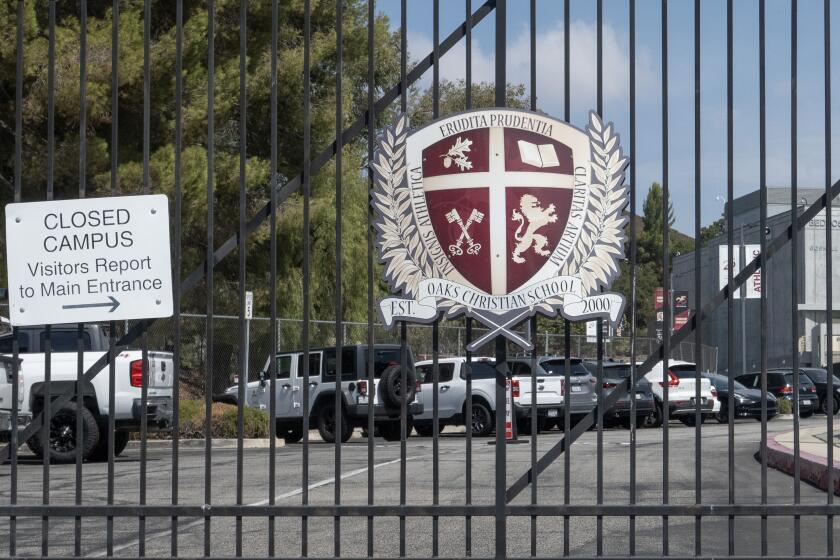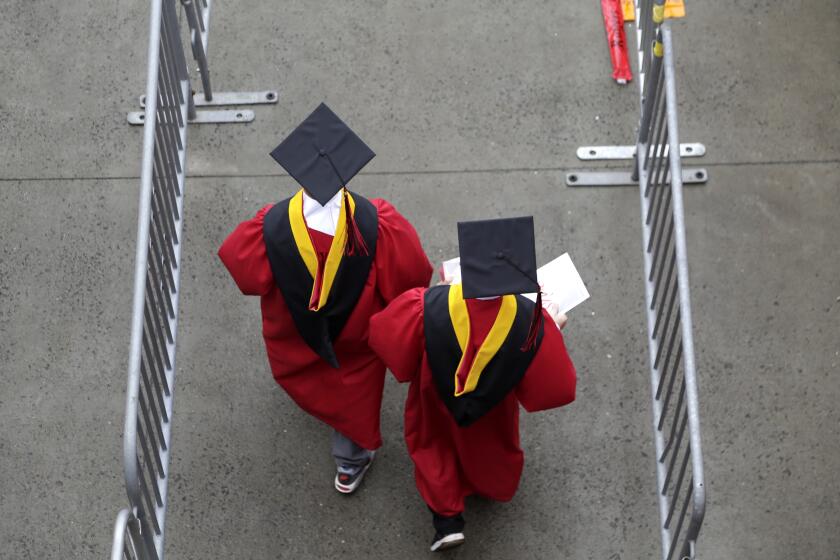Time-Tested : Educator Started College in 1947 and Just Kept Going--and Going
Raul Arreola, 63, is a living definition of the term “perennial student.”
He started taking classes at California State University, Los Angeles, the semester the school opened in 1947. Today, 40 years later, he is still studying. He has not missed more than a single quarter since he started. That is more than 200 courses, an incredible 672 college units--most of them acquired during the evening.
Why?
“I just love knowledge and love learning,” said Arreola, who also spends his days in school--as an assistant vice principal at Hollenbeck Junior High School in Boyle Heights. “Sometimes I think other teachers have quit studying. You know, they go out and play golf on weekends. I study.”
Amply Credentialed
He has acquired bachelor’s and master’s degrees in education and another master’s in Mexican-American studies. He also has seven separate teacher’s credentials. He has enough units for another 10 master’s degrees, but says he never cared enough about degrees to follow specific requirements to get them. Overall, he says, he’s been a B student.
“At one time I had taken all the art courses they were offering,” he said. “I guess I could have had four separate master’s degrees in art, but you have to take them all within seven years to make sure your knowledge is recent. I never really tried to do that.”
For all his studies, Arreola is not a master of trivia. Instead, he says, he would like to think of himself as a “humanist” whose interests bridge the gaps between college departments.
Apart from art, he says, he has focused on history, math, urban studies and education courses. Not being what he calls “the sort to go too deep into one thing,” he has also taken such courses as economics, philosophy, dream analysis and auto mechanics. The only subject he says intimidates him too much to try is music lessons. But that hasn’t stopped him from taking a variety of music history courses.
Started on Doctorate
Arreola said he started on a doctoral program in administration at Claremont College in 1979 but was unable to keep up the pace. “Besides, administration is pretty dull,” he said.
“It’s phenomenal and almost a little weird, how much he’s studied,” said Rico Burrell, manager of the school’s public affairs office. “When we first heard how many units we had, we asked the office to check it again to make sure they had it right. We’re submitting him to the Guinness Book of World Records.”
Not bad for a high school dropout.
Arreola is the son of Mexican parents who moved to Los Angeles before he was born. His father was an illiterate factory worker who never attended school, and his mother was a sixth-grade dropout. He was the oldest son among their eight children.
Military Service
He quit high school in his senior year in 1942 to join the Army. After his discharge, he finished up his high school diploma work and entered Los Angeles City College, which was then at the current site of Cal State L.A. For reasons that are still not clear to him, he says, he became the first and only one in his family to go to college.
“My father always thought I was smart and he had saved up $800 for me to go to college when I got out of the service,” Arreola said. Fortunately, he said, he was able to spare his father the funds and go through school with the help of veterans’ benefits.
Arreola’s ID card number, which he still has, was 381. Since then, the school has issued 600,000 more.
When he started, Harry S. Truman was president and Jackie Robinson was integrating the major leagues. Students were carrying slide rules, not pocket calculators, to class.
Few Latinos Enrolled
Most colleges had few, if any, Latino students, in 1947. Arreola recalls only about a dozen at Cal State L.A. in 1947.
Today the campus calls itself the most ethnically diverse in the country. About 26% of its students are Latino, although Arreola’s principal criticism of the school is that it still does too little to attract Latinos from the Spanish-speaking communities surrounding the campus. Arreola himself lives in El Sereno, less than a mile from campus.
After graduation he became a teacher and taught a variety of subjects at different grade levels. He became active in union activities in the late 1960s and subsequently served for 12 years as director of the Mexican American Education Commission, an advisory board to the Los Angeles Board of Education. When the group was reorganized four years ago, he was reassigned to Hollenbeck Junior High.
Following His Example
In the meantime, Arreola’s two grown children are following in his footsteps. His daughter has a master’s degree in art, and his son is finishing a doctorate in history, he said. He recently remarried and now has a 21-month-old baby.
Both father and children make a point of skipping commencements.
“It just seems to us that graduation ceremonies feel like you’re putting an end to your education,” he said.
This weekend, Arreola plans to miss yet another graduation at Cal State, when he is scheduled to formally receive his master’s degree in Mexican-American studies. He already has plans to get his certificate through the mail.
What, he was asked, is the most important thing he has learned over the years?
For the answer, he searched not his memory, but the worn hallways of the largely Latino inner-city junior high where he now works.
“I’ve learned that people who need clothing and shelter and food cannot think of learning,” he said.
“People ask why certain people--and I’m speaking of Hispanics--do not achieve much in school. I’ve had the luxury of being able to learn. I’d guess that 80% of the students here do not have that luxury. If you only have two meals a day, and those are the ones you get at school, how can you concentrate on learning?”
When he retires, Arreola said, he would like to teach part time--at Cal State LA. In the meantime, he said, he is looking forward to taking a summer course in computer art.
More to Read
Sign up for Essential California
The most important California stories and recommendations in your inbox every morning.
You may occasionally receive promotional content from the Los Angeles Times.










